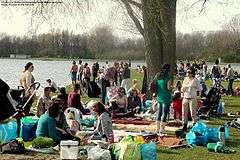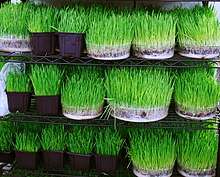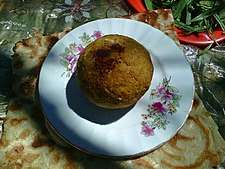Sizdah Be-dar
Sizdah Bedar (Persian: سیزدهبدر – Sizdabedar),[1][2] (lit. Thirteen Outdoor) also known as Nature's Day (روز طبیعت – Ruz e Tabi'at),[3] is an Iranian festival held annually on the thirteenth day of Farvardin (same as Aries), the first month of the Iranian calendar, during which people spend time picnicking outdoors.[1] It marks the end of the Nowruz holidays in Iran.[4]
| Sizdah Bedar | |
|---|---|
 Iranians in the Netherlands celebrating Sizdah Bedar, April 2011 | |
| Observed by | |
| Celebrations | Picnicking outdoors |
| Date | April 1 |
| Frequency | annual |
| Related to | Nowruz, Charshanbe Suri |
Observances
Sizdah Be-dar is celebrated on the thirteenth day[5] of Nowruz, the Iranian New Year. It is celebrated by leaving houses to join nature, and spending the day outdoors.
Releasing sprouting greens back into nature


A ritual performed at the end of the picnic is to throw away the greenery (سبزه – Sabze) collected for Haft-Seen, the customary setting of Nowruz in Iran. Touching someone else's greenery on this day or bringing it back home is considered a bad omen.
Knotting the greenery
Knotting the greenery (سبزه گره زدن - Sabzeh gereh zadan) is customary for young single people, especially young girls. They tie the leaves of the greenery before discarding it, expressing a wish to find a partner or a husband.
Lie of the Thirteen
Lie of the Thirteenth (دروغ سیزده – Dorugh-e Sizdah) is the Iranian version of the prank-playing April Fools' Day which is observed on the first or second day of April in Iran, on the day of Sizdah Bedar. Pranks have reportedly been played on this holiday since 536 BC in the Achaemenid Empire.[6][7][8]
Chahardah Be-dar
Chahardah Be-dar (Persian: Čahārda' be Dar – چهارده به در) is the fourteenth day of Nowruz, which is celebrated only in Lorestan Province. Lurs stay home on the thirteenth day of Nowruz, referred to as the Strange Thirteen (سیزده غریب – Sizdah e Qarib) by them. Instead, they picnic outdoors a day after Sizdah Be-dar.
See also
| Wikimedia Commons has media related to Sizdah Be-dar. |
- Nowruz
- Iranian festivals
- Public holidays piche
References
- Shahbazi, A. Shapur. "NOWRUZ ii. In the Islamic Period". Encyclopædia Iranica. Retrieved 8 January 2012.
- Mosaheb, Gholamhossein, ed. (2002) [1966]. "سیزدهبدر" [Sizde be.dar]. The Persian Encyclopedia (in Persian). 1 (2nd ed.). Tehran: Amirkabir. p. 1404. ISBN 964303044X.
- "Iranians mark Sizdah Bedar in nature". Press TV. 1 April 2016.
- "Iranians mark Sizdah Bedar in nature". mypersiankitchen. 2 April 2010.
- https://theotheriran.com/2016/04/03/photos-sizdah-bedar-nature-day-in-iran/ Sizdah Be-dar, literally “thirteenth in outdoors”, is an Iranian festival, and part of the Nowruz celebration rituals, held annually on the thirteenth day of the first month of the Iranian calendar (Farvardin).
- April 1st Traditions from Around the World. Taylor Mahaffey. 3 April 2014.
- April Fools’ Day in Iran
- April Fools' Day 2016: how did the tradition originate and what are the best pranks?. Emily Allen and Juliet Eysenck. 17 March 2016.
External links
- Sizdah-Bedar in Delft (Netherlands) on YouTube (Video)
- Animation about Sizdah-Bedar on YouTube (Video)